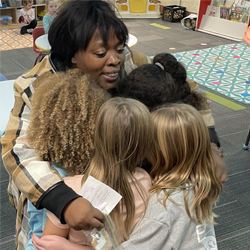
Behavior is Communication
Behavior is Communication
Communication is often thought of as the words we use to express ourselves. And as parents and caregivers, we are quick to overlook behavior as a form of communication. However, our actions and reactions can speak as loudly as our words.
There are two forms of communication: verbal and nonverbal. Verbal communication is the words we use and how we use them, such as our pitch or tone of voice. And as stated above, verbal communication is most commonly regarded as expressing thoughts and feelings. Nonverbal communication, however, is the manner in which we express ourselves (communicate) through actions and body language, and it can be intentional or unintentional. Some examples of nonverbal communication include facial expressions, hand gestures, eye contact (or the lack thereof), yawning, fidgeting, and even the amount of space one may provide themselves in the setting.
Think about the messages you send to your children through your behavior. Are you modeling the behavior you want to see in them? Do your actions align with the values and principles you are trying to instill?
It's important to remember that our children's behavior is a form of communication as well. Often when they misbehave, it's because they are trying to tell us something. They may be feeling overwhelmed, frustrated, or even just seeking attention. The behavior displayed (such as kicking, hitting, crying, throwing items, etc.) is the child's way of sending a message because they don't know how to explain what they believe to be wrong.
By taking the time to understand the underlying message behind their behavior, we can respond in a way that addresses the root cause rather than just punishing the behavior itself. We often hear how consistency in routine is essential for children. Similarly, consistency in support and proper guidance is also crucial… especially when the child may be taking inappropriate action. If done with care, the manner in which we respond can start correcting the destructive behavior and forming a safer, more comfortable feeling in the child.
While it may seem contradicting, we can reduce poor performances by showing respect and may prolong the issue if met with punishment. All people want to feel respected, and that includes children. When kids feel valued and that their feelings or needs are understood rather than ignored, they no longer have a reason to express themselves destructively. A punishment pauses the behavior; it does not correct it, and it does not solve the child's problem. Instead, we need to work to understand the issue to provide a better solution or at least a more appropriate means to communicate the problem. And not only do we help the immediate need, we can also instill social skills and teach the ability to problem-solve… which will benefit the child well into the future.
One way to improve our understanding of our children's behavior is to practice active listening. Active listening means paying close attention to verbal and nonverbal cues - what they are saying and how they are behaving - and then reflecting on what we observed with the child(ren). As the listener, you should not only listen to what they are saying but also pay attention to the emotions that are present, as well as their body language. By doing this, we can gain insight into their perspective and respond in a more effective way.
We can foster positive change by being mindful of our behavior and actively listening to our children. We can improve our communication and build stronger relationships. At Boys & Girls Clubs of the Sioux Empire, we uniquely pair our educational programming with a focus on social/emotional learning based on a need we saw drastically increase over the past few years.
In 2020, we saw children's behaviors at an all-time high and the daily struggle these kids went through as they navigated a post-COVID world.
- Pre-pandemic, 2016-2020, anxiety and depression among children 3-17 had increased by 30%.
- Post-pandemic, 1/3 of parents said their children always feel nervous, anxious, or stressed. One-quarter of parents said their children are feeling down, depressed, or hopeless all the time.
- 1 in 4 parents have missed work to care for a child's mental health needs.
- Nearly 8 out of 10 say their child's mental health has impacted them during work hours.
- 1 in 3 mothers of children under 5 have missed work to address their child's mental health needs.
Due to these staggering facts, we launched a Student Success program with a team of specialists focusing on behavior as a form of communication.
The Student Success program uses evidence-based strategies and effective interventions to improve student behavior. Even more, though, the program has a process used to understand the purpose or function of a child's behavior to develop targeted interventions and teaches children the appropriate social behaviors and skills they need to be successful. The team encourages children to track and reflect on their behavior throughout programs to improve self-awareness and self-regulation. Successful self-regulation empowers youth to utilize these skills as they progress through our programs and into adulthood.
The Student Success team even takes it one step further and works to train other staff how to better address behaviors and challenges in their classrooms. Our teachers meet each child where they are, and this is just one example of how we can do so. Our entire organization works as a team to ensure everyone is successful, which looks different for every kid.
Naomi Blank
Student Success Director

